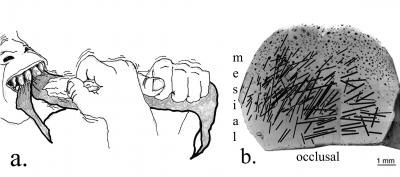Two-Million-Year-Old Jaw Has a Lot to Say About the Origins of Human Handedness
Scientists have discovered one of the earliest examples of handedness in an ancient human
/https://tf-cmsv2-smithsonianmag-media.s3.amazonaws.com/filer/1f/21/1f214edf-ce06-41d4-b1c6-0274b9b726fe/125005_web.jpg)
From sports to cutting paper—handedness always comes into play. And the discovery of a nearly two-million-year-old jaw with cut marks on the teeth may suggest that handedness is no new trend.
The vast majority of modern humans are right handed—roughly 90 percent—with only a small fraction of the population rocking the south paw. Researchers are still teasing through the factors that determine this trend, but the general idea is that it is associated with brain lateralization, or which side of the brain handles various functions.
“When you look at the fossil record, you find left cortex dominance also where you get language,” Columbia University anthropologist Ralph Holloway tells Smithsonian.com. “If part of your brain is more devoted to one hand or the other, that side gets larger.”
So researchers believe that this history of handedness can tell them about how brains evolved. In fact, many think this preference could have gone hand-in-hand as our ancestors developed their communication skills.
The fossil jaw, described in a recent study published in the Journal of Human Evolution, dated back 1.8 million years and is thought to belong to Homo habilis—one of the earliest members of the Homo genus. The team of researchers from the University of Kansas identified a series of scratches on the surface of teeth that were slanted diagonally to the right across the lip-side of the teeth.
While marked-up teeth might not seem of much importance, the scientists believe the angle and position of the marks suggest that this was a right-handed individual who was cutting some type of food—such as a hunk of raw meat—while it was being held held in her mouth.

If these marks were in fact made by a right-handed Homo habilis, it would make it the oldest-known human fossil with signs of favoring one hand over the other. These little scratches could provide a roadmap for anthropologists about the development of ancient humans’ brains sans complete skeletons—a rarity in for ancient hominid fossils.
But while this research is promising, these marks have only been found on one specimen so far, Eva Botkin-Kowacki reports for the Christian Science Monitor. "My concern is that they really don't spend enough time on other explanations for these phenomena, the presence of these scratches and their directionality," Bernard Wood, a paleoanthropologist at George Washington University tells Botkin-Kowacki. "It's a really interesting observation that only time will tell whether that observation has been over-interpreted."
The study, however, could prompt others to take a closer look at ancient human teeth to see whether similar marks appear. "One specimen does not make an incontrovertible case," study author David Frayer says in a statement. "But as more research is done and more discoveries are made, we predict that right-handedness, cortical reorganization and language capacity will be shown to be important components in the origin of our genus."